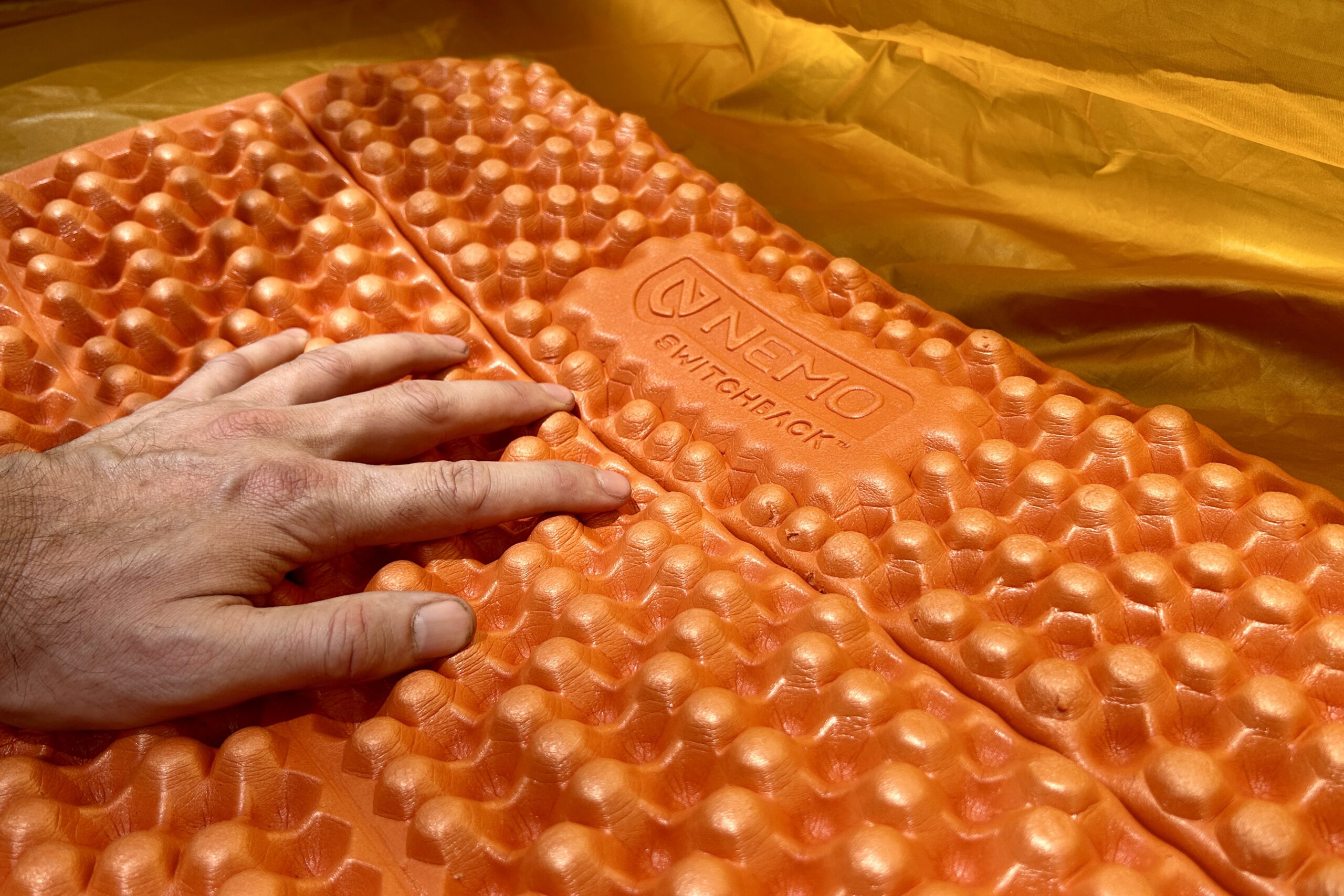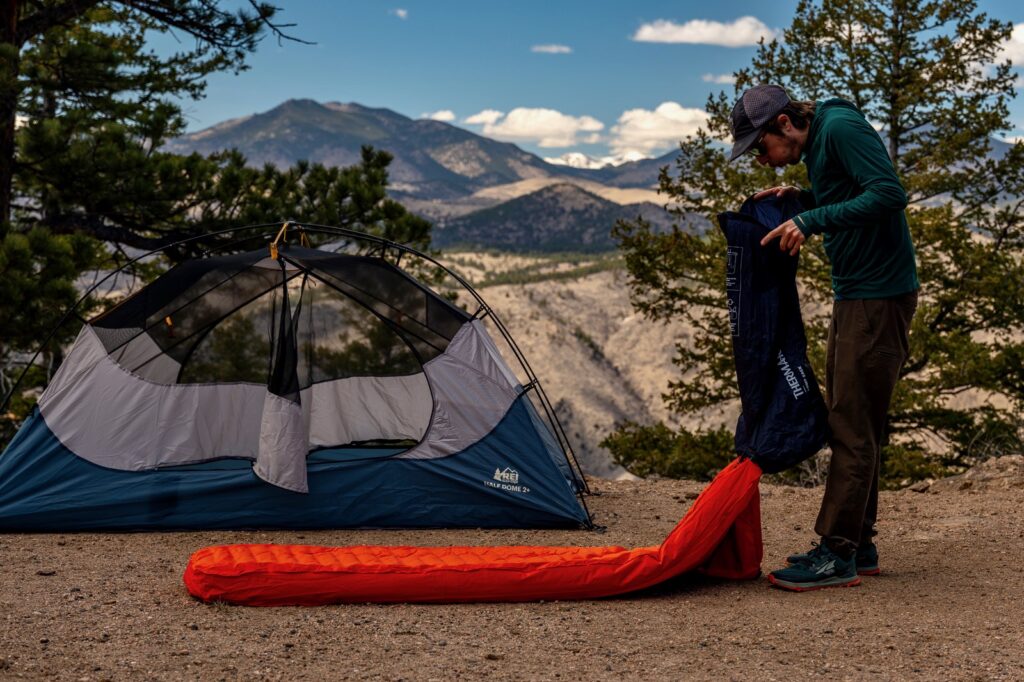
Bottom Line
If you’re a lightweight backpacker whose top priorities are simple, durable, and affordable gear, the NEMO Switchback sleeping pad is a tried and true sleeping pad. CleverHiker founder Dave Collins used this pad on Oregon’s famous 40-mile Timberline Trail and found it reliable and functional. He also thru-hiked the PCT with a pad nearly identical to the Switchback, so he’s a big advocate of the closed-cell foam pad.
At less than a pound, this closed-cell foam sleeping pad is among the lighter backpacking sleeping pads we’ve tested, but it’s also exceptionally easy to use. With a foam pad, there’s no inflation or deflation to deal with as a daily task. More importantly, there’s no risk of your pad developing a leak, which can be annoying to deal with in the field, and sometimes finding and fixing pad punctures can be tricky.
Another benefit of the Switchback, and foam pads in general, is that they’re great to pair with an air pad for cold weather or winter camping. The Switchback will provide extra puncture protection on ice and snow and boost the insulation of your air pad, which can turn a warm three-season air pad into a winter-worthy sleeping system.
But there are tradeoffs with using a foam pad like the Switchback. The biggest drawback is that foam doesn’t deliver the same cushy comfort as air pads. The Switchback is less than an inch thick, so it’s a better fit for hikers who like sleeping on firm surfaces. Side sleepers might not like the Switchback because it can put more pressure on the shoulders and hips.
The Switchback also has a pretty low R-value, so its warmth is best for mild weather and summer use. It’s as easy as it gets to use, and can double as a seat around camp or on the trail. But it packs up much bulkier than an air pad. So you’ll need to account for that extra space in your pack or strap it to the outside.
All things considered, for weight-conscious summer hikers, those on a tight budget, and backpackers who tend to be tough on gear, the Switchback may be precisely what you’re looking for.
Quick Specs

NEMO Switchback
Best Foam Sleeping Pad
CleverHiker Rating: 4.3/5.0
Price: $60
Weight: 14.5 oz.
R-Value: 2
Thickness: 0.9 in.
Pros
- More durable than air pads
- Affordable
- Quick to pack/unpack
- Doubles as a sit pad
- Quiet
Cons
- Not as comfortable as air pads
- Bulky
- Not warm enough for sub-freezing temps

Comfort
Let’s be honest here. Comfort is not the strong suit of the Switchback, or any closed-cell sleeping pad for that matter. If you’re using it as your only sleeping pad (not doubling up pads for winter use), the Switchback will be most suitable for the type of hikers who like to sleep on firm surfaces and sleep comfortably under unideal conditions. If you sleep like a rock and generally don’t feel like you need extra cushy comfort, the Switchback could be a great fit.
But for many hikers, most of the CleverHiker team included, the Switchback just doesn’t deliver the comfort we want from a stand-alone backpacking sleeping pad. Don’t get us wrong, we all still own this pad and really like it, but we tend to use it more to add protection and extra insulation in winter conditions. Also, after hundreds of uses, the foam of the Switchback will compress and eventually wear out, which makes it less comfortable the longer you use it.
That said, the Switchback can add comfort in ways an air pad can’t. It’s versatile as a sit pad to stay out of the dirt and save the seat of your pants around camp or during breaks on the trail. And you’ll never have to worry about puncturing the Switchback and waking up in the middle of the night on the cold, hard ground, fumbling around to try and repair an air pad.
All things considered, the Switchback gets low scores in the comfort department, but it can still be a great fit, depending on your preferences and needs.

Weight & Packability
The NEMO Switchback is a pretty lightweight backpacking pad, making it a good choice for ultralight backpackers. At 14.5 ounces, the Switchback will be easy to carry for thousands of miles, and some shorter hikers even trim off sections of the pad to save more weight.
Plus, you won’t find an easier pad to set up: just unfold and lay it down. Unlike air pads that need to be unrolled, inflated, and deflated, you can save time and energy in the backcountry relaxing.
The biggest packing downside of the Switchback is that it’s very bulky. Measuring 20 inches long by 5 inches tall and 5.5 inches deep, this pad is best carried on the outside of your pack, which isn’t ideal. Additionally, its foam structure doesn’t compress well, so you’ll have to decide if its large packed volume will work for your backpacking style.
Additionally, the Switchback doesn’t have the best warmth-to-weight ratio compared to insulated ultralight air pads. Many air pads deliver much more warmth than the Switchback at roughly the same weight (or even less). But they cost a lot more.

Warmth
If you’re backpacking in summer and fair-weather conditions, the Switchback will keep you warm when paired with a quality sleeping bag. Its R-value of 2 will keep you warm to around 40°F, making it a solid option from late spring until early fall.
The closed-cell foam construction and tall nodes trap body heat more effectively than you’d expect from its thin profile, and a one-sided metalized thermal film surface helps reflect heat back to you on chilly nights. This pad isn’t thick enough for freezing nights, but it’s an essential piece of gear for pairing with an air pad when winter camping to extend the comfort range of your gear setup.
However, the Switchback is not suited for overnight temps below 40°F, and may not be a good fit for cold sleepers. Its 0.9-inch thickness means there’s minimal distance between you and the cold ground, which can result in heat loss on especially cold nights. Gear Tester Ian Krammer uses this model during annual February trips in central Utah, where it is much too cold on its own for the 20°F nights. However, he loves pairing the Switchback with a lightweight air pad for ultimate warmth and insulation off the ground.

Ease of Setup
You won’t find an easier setup than a closed-cell foam pad like the NEMO Switchback. Thanks to its foldable accordion design, there’s only one step to set it up: unfold and lay it out. Where air pads can be a bit fussy and slow since they require inflating, deflating, a pump sack, and micro-adjustments, the Switchback’s rigid structure is very simple.
With the Switchback, you won’t need to worry about air leaks or malfunctions. Packing it up is equally fast for a quick departure in the morning. These features make the Switchback a practical and efficient choice for multi-day hikes.

Durability
With no moving parts, no inflatable chambers, and a simple folding design, the NEMO Switchback is nearly indestructible. It will last for months of hard use with almost no maintenance. If you’re heading out on a rugged adventure, the closed-cell foam design eliminates the risk of punctures or valve failures. You’ll never have to worry about the pad deflating in the middle of the night, either. Its toughness also makes it multi-functional as a sit pad when it’s time for a break.
The one knock on the Switchback’s durability is that foam pads compress over time and from lots of use. So you’ll still get plenty of use out of your foam pad, but over time it won’t hold as much loft and will become less comfortable. When this happens, say over the course of a many months long thru-hike, it’ll be time to replace the pad. That said, the Switchback will be much more durable and will take a beating compared to any air pad.

Should You Buy the NEMO Switchback?
If you dug into any CleverHiker staff’s gear bins, you’d probably find a closed-cell foam pad like the NEMO Switchback. It might not be ideal for every condition, but this kind of pad is often needed in our camping system.
The NEMO Switchback is a solid choice for budget-conscious “out-like-a-light” backpackers who want a durable, lightweight, easy-to-use sleeping pad. Closed-cell foam designs like this offer a hassle-free experience, so you don’t need to baby this pad since it can’t be punctured or leak air.
The Switchback is best used in mild temperatures (40°F or warmer), making it a good choice for summer backpacking trips. That said, it’s also a great addition to a winter sleep system, where it can add insulation and puncture resistance under a three-season-rated air pad.
However, the Switchback isn’t a good fit if you’re a light sleeper. If you want frontcountry comfort in the backcountry, this is not your pad. The firm egg-carton surface is less than an inch thick, so it provides a pretty firm sleeping experience. You’ll also want to be careful where you set it up to avoid the feeling of lumpy, bumpy ground under your pad.
That said, if you sleep well on firm surfaces, appreciate ease of use and durability, and want a very affordable option, the Switchback is our top choice for closed-cell foam backpacking pads.

What Other Backpacking Pads Should You Consider?
On our list of the best backpacking sleeping pads, you can see how the NEMO Switchback compares to our other favorites. Otherwise, here are some strong contenders:
Therm-a-Rest Z Lite Sol Review: The Z Lite Sol was our favorite foam sleeping pad for over a decade, and it’s nearly identical to the Switchback when it comes to comfort, warmth, price, durability, and versatility. The Z Lite is a half-ounce lighter and a bit thinner, but the experience is pretty much the same. So, if you like the look of one pad over the other or can find one cheaper, they perform very similarly.
Big Agnes Rapide SL Insulated Review: This pad is more than twice the price of the Switchback, but it offers twice the comfort at an outstanding value for folks on a budget. For a few ounces more, this pad can handle below-freezing temps, has three times the thickness, and delivers solid durability for an air pad. Oh, and it packs down to the size of a 12 oz can!
Klymit Static V2 Review: If you’re a summer backpacker on a budget but want more comfort with an air pad, the Static V2 is a good alternative. This minimalist, super compressible option weighs only a bit more than the Switchback but is much thicker and cushier – though it has an even lower R-value, so it works best in mild temps. This pad doesn’t have the same quality level of the other air pad on our list, but it’s much more affordable.
NEMO Tensor All-Season Review: If you want to see what the other side of the sleeping pad market looks like, check out the Tensor All-Season. This pad earned some of our highest testing scores for comfort, weight, warmth, ease of use, and durability for an air pad. It’s much more expensive, but if you backpack a lot and want to prioritize comfortable sleep, this is one of the best options.


















